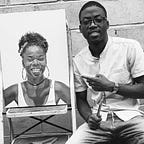Hyperrealism: “Is it a photo?” — When Art Imitates Reality
Imagine being in a place where you’re not quite sure what’s real, not even if it’s light captured by a device from some real moment (photography). Perhaps this article is one of those places. This article is not about science fiction, and if you’re one of those who believe we’re truly in a Matrix, it’s not about The Matrix. This article is about the artistic movement that challenges itself to be more real than reality: Hyperrealism.
Year of emergence: 1960s
Location: United States and Europe
Notable artists: Carole Feuerman, Duane Hanson, John De Andrea, Chuck Close, Richard Estes, Audrey Flack, Duane Hanson, and Denis Peterson.
Hyperrealism is a contemporary art movement primarily expressed through painting, drawing, and sculpture. Its works bear strong resemblances to photographs and often seek to surpass photography by introducing details, light, and shadows that photos lack.
This is often achieved through the large scale of many works in this movement, enhancing the awe and impact of the pieces but also presenting significant challenges to the artists.
Origins and Influences
Leonardo Da Vinci and Albrecht Dürer are considered the “precursors” of the commitment to create precise and realistic images of nature, planting the seeds of Hyperrealism back in the Renaissance.
The term “hyperrealism,” originally used in French (hyperréalisme) by art dealer Isy Brachot in 1976, referred to art created with a more realistic approach. Brachot used it as the title for a major exhibition and catalog at his Brussels gallery. Interestingly, this exhibition was primarily dominated by photorealist artists. Over time, distinctions between Photorealism and Hyperrealism became more apparent.
In the early 21st century, american painter Denis Peterson, often associated with Photorealism, was the first to apply “hyperrealism” to his own work and the “rebel group” of artists around him.
Rebelion for what? Many artistic movements emerged drawing from those that came before and as a response to earlier ones. In the case of Hyperrealism, it was a reaction against abstract and conceptual art that prevailed at that time.
Pop Art was also instrumental in the emergence of Hyperrealism, as many Pop artists sought some realistic resemblance in their works.
Characteristics
- The pursuit of precise representation of reality;
- Attention to detail;
- Use of techniques and materials that allow the creation of images resembling photographs;
- Hyperrealist works are usually large and exhibit a high degree of detail, including shadows, reflections, and textures;
- The goal of hyperrealist artists is to create images so convincing that they appear almost real, leaving the viewer questioning what is real and what is representation.
